| Here, exemplarily some of the science highlights obtained from the simulations are shown. The spand from the largest scales probed by Clusters & Groups down to Galaxies and AGNs and are meant to demonstrate, how well the simulations compare with recent observations. | ||||
Large Scale Structure |
||||
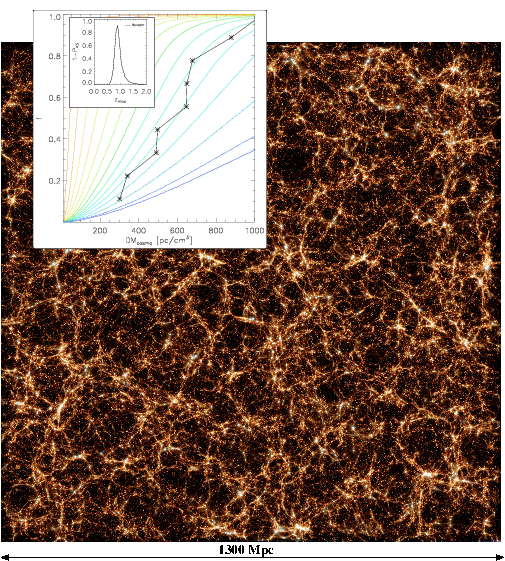
|
Dispersion measure of Fast Radio BurstsBased on the dispersion measures (DMs) obtained from Box2/hr and Box1/mr we showed that the foreground-subtracted DMs are consistent with a cosmological origin, corresponding to a source population observable to a maximum redshift z ~ 0.6-0.9, depending on different models for their spatial distribution. The distribution of the observed FRB fluences are consistent with FRBs being standard candles, each burst producing the same radiated isotropic energy. The data imply a constant isotropic burst energy of ~ 7×1040 erg if FRBs are embedded in host galaxies, or ~ 9×1040 erg if FRBs are randomly distributed. These energies are one to two orders of magnitudes larger than had previously been inferred. Within the constraints of the available small sample of data, our analysis favours FRB mechanisms for which the isotropic radiated energy has a narrow distribution in excess of 1040 erg. Figure is taken from Dolag et al. 2015 |
|||
Clusters & Groups |
||||
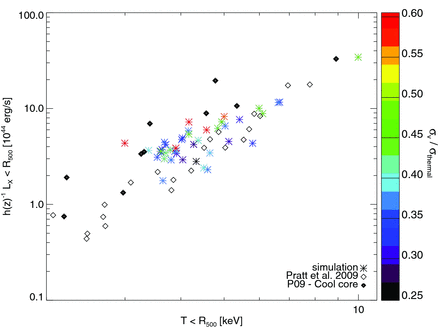
|
X-ray scaling relations of clustersLX-T scaling relation for galaxy clusters taken from Box3/hr of the Magneticum Pathfinder set, obtained from Chandra mock spectra produced with PHOX, in comparison with observations from Pratt et al 2009. Mock observations are shown as crosses, colour coded according to the fraction of the dispersion of the gas velocity and the thermal velocity, calculated in the region within R500. Observational data points are shown as black diamonds, with cool core clusters marked with filled symbols.Figure is included in Biffi et al. 2013 |
|||
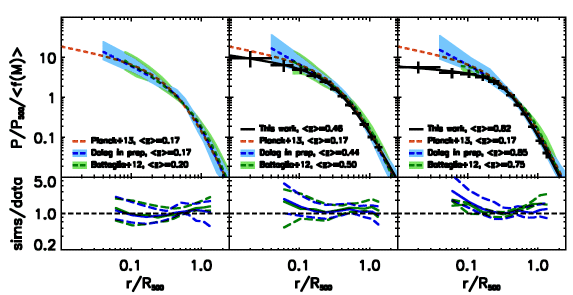
|
Pressure profiles of clustersAverage pressure profile for low-z (z <0.3; left panels), intermediate-z (0.3 < z < 0.6; middle panels), and high-z (z > 0.6; right panels) clusters from SPT (black data-points with error bars). We show, for comparison, average profiles for simulated clusters at similar redhsift with M500 > 3*1014Msol, taken from Box1/mr of the Magneticum Pathfinder simulations (blue shaded profile). Figure is included in McDonald et al. 2014 |
|||
Galaxies |
||||
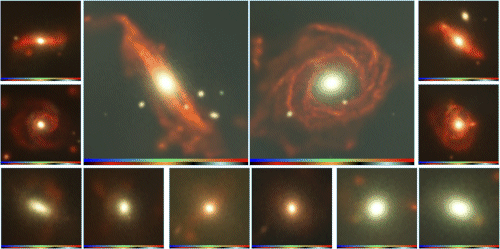
|
Spirals & EllipticalsGalaxies in the simulations show a clear bimodal distribution and environmental effects like the red sequence in galaxy clusters is reproduced (see Saro et al. 2006). Rotating the galaxies according to their angular momentum vector allows to calculate the circularity distribution of the gas and star particles, which then can be used to classify disk and elliptical galaxies. The left picture shows two different projection directions of an example of 3 spiral and 3 elliptical galaxies from the Box4/uhr simulation. |
|||
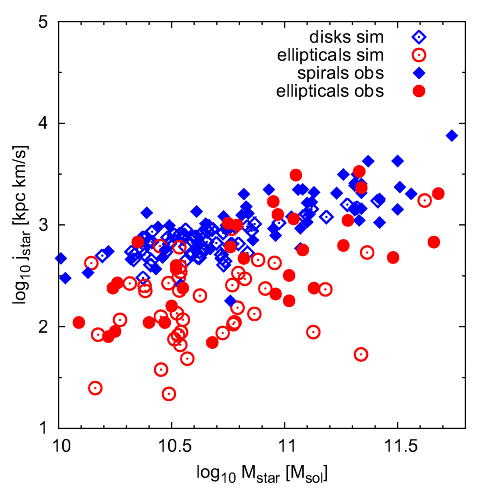
|
Angular Momentum of Spirals & EllipticalsShown is the angular momentum of the stars in simulated galaxies as function of their stellar mass, taken from Box4/uhr of the Magneticum Pathfinder set (filled symbols), and compared to observational results from Romanowsky & Fall 2012 (open symbols). Here we used the circularity parameter calculated for the simulated galaxies to classify the simulated galaxies as disk and elliptical galaxies.Figure is included in Teklu et al. 2015. |
|||
AGNs |
||||
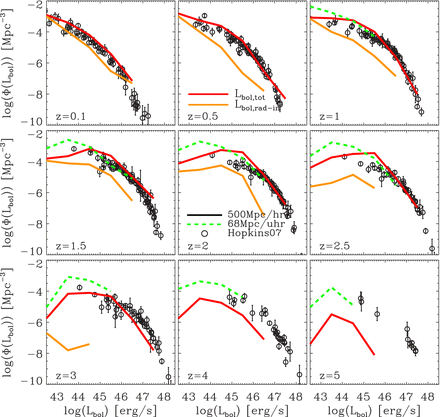
|
AGN luminosity functionEvolution of the bolometric AGN luminosity function for Box2/hr (red solid lines) and Box4/uhr (green dashed lines) of the Magneticum Pathfinder set at different redshifts from z = 0 to z = 5, compared to the observational data of Hopkins, Richards & Hernquist (2007) (black open circles). At higher redshifts (z = 3-5), the amount of AGN is underestimated at the hr resolution level due to resolution effects, while the amount of faint AGN in the uhr resolution is still in good agreement with the observations. The orange lines illustrate the increasing contribution to the total luminosity by radiatively inefficient AGN with decreasing redshift.Figure is included in Hirschmann et al. 2014 |
|||
Students Training |
||||
| In our student training program with the focus on high performance computing (HPC), we allow our students to learn the handling of large, cosmological data sets and cosmological simulations via hands-on exposure to the Magneticum Pathfinder simulations as well as allowing them to perform complementary simulations. In particular, these young students are playing an important role, not only in the scientific exploitation of the simulated data, but also in addressing very technical aspects of supercomputing that are central to the advancement of the underlying physical modules used in the simulations. Some of the finished PhD and Master thesis can be found below, a more complete list of students projects can be found under CAST students projects. | ||||
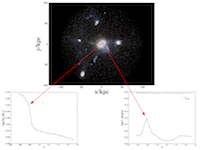
|
Black Holes in the Magneticum Pathfinder SimulationsMagneticum Pathfinder Simulations are analysed comparing the simulation with observations, i.e. the relation between the black hole mass and the stellar mass, the M-sigma-relation, the stellar mass functions or the luminosity functions at various redshifts. Here, galaxy mergers play an important role for the black hole growth and thus for the appearance of the AGN, which is depicted in the figure on the left. The graphs below show the mass growth and the light curve of the black hole, where the peak in the luminosity appears during a merger. Fainter AGN can be triggered by mergers or smooth gas accretion.Download Master Thesis Lisa Bachmann, 2014 |
|||
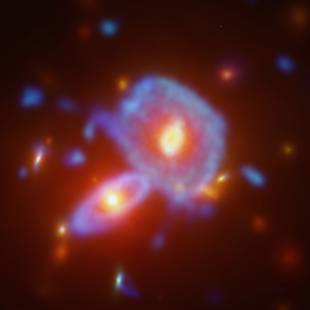
|
A Disk-Disk Major Merger Event in a Zoom-SimulationWith the aim to understand the formation of galaxies and especially the impact of the gas component and the feedback on the evolution of elliptical galaxies, we performed high-resolution zoom simulations of galaxies selected from a large cosmological box (Gpc in size), which are forming at the border or inside a void structure at present day. The example on the left shows, within a self consistent cosmological context, the formation of a disk galaxy from a redshift of z=10 to z=0.45, where it suffers a major merging event with another massive disk galaxy. This causes a starburst and changes the morphology of the two galaxies that then form a single spheroidal galaxy. This is an event that can be seen in the present day universe, for example in the famous Mice Galaxies or the Antennae Galaxies. Our spheroidal galaxy undergoes another dynamical event during the last 2 Gyrs of its life until the present day that is also a major component of galaxy evolution: a massive dry minor merger. This merger leaves shell-like structures around the galaxy as a signature that is visible for about 200-500 Myrs, a phenomenon that can be observed at present day, for example in the Arp 227 Galaxy.Download Master Thesis Download Movie 1920x1080 (27MB) YouTube: watch (do not forget to select HD using the gear icon) David Schlachtberger, 2014 |
|||
